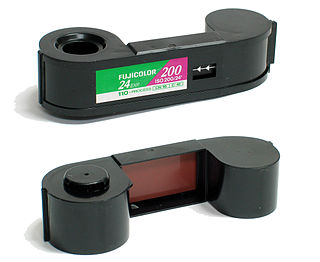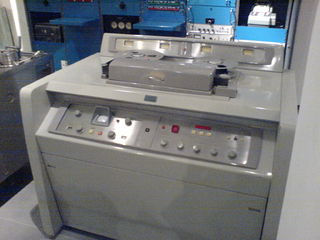

Polavision was an "instant" color home movie system launched by Polaroid in 1977.


Polavision was an "instant" color home movie system launched by Polaroid in 1977.
Unlike other motion picture film stock of the time, Polavision film reproduces color by the additive method, like the much earlier Dufaycolor film. In essence, it consists of a black-and-white emulsion on a film base covered with microscopically narrow red, green and blue filter stripes. [1] [2] It was instant in the sense that it could be very quickly and easily developed in the Polavision processing unit after it was removed from the Polavision camera, ready for viewing in only a few minutes.
The Polavision cartridge called Photo tape cassette is a small rectangular box containing the film reels and a prism letting in light for projection through a film gate. [2] The film format is similar to the super 8 mm format, but without the Polavision tabletop viewer the only way a Polavision film can be shown is by destroying the cartridge and projecting the removed film with an ordinary super 8 mm projector or transferring it to video with a telecine system.
The Polavision system was a major commercial failure, [3] and was discontinued in 1979. However, the underlying technology was improved and used as the basis for the Polachrome instant color transparency system introduced in 1983.
Due to the light loss caused by the filtering layer, which allows only red, green or blue light to pass through any given point on it, the film had relatively low light sensitivity (40 ASA) and the developed footage has an overall veil that appears to be a neutral gray. [1] The system features a standalone tabletop viewer designed to minimize the problems inherent in projecting such dense film. [1] Somewhat resembling a small television, it projects the inserted film cartridge onto its translucent screen from behind, but critics from publications like Consumer Reports called the images "murky and dark". Despite this (or perhaps because of it), the format was used by artists, including Charles and Ray Eames, Stan Brakhage and Andy Warhol.
One market niche Polaroid promoted was the field of industrial testing, where the camera would record, for example, the destruction of a pipe under pressure. This type of use was moderately price-insensitive, with the ability to get the images quickly (thus reducing wasted crew time) a very positive selling feature.
The system was late to market and had to compete with upcoming Betamax and VHS videocassette-based systems, which in the pre-camcorder era of the late 1970s had the disadvantages of much greater bulk and much higher initial hardware cost. However, a standard videocassette ran for at least an hour at the highest-quality speed, while a Polavision cartridge contained less than three minutes of film, at a far higher per-minute cost than the finest videocassette tape. It could not be erased and reused, or shown on a real television set with a larger screen, and there was no sound. Polavision proved to be an expensive failure, [3] and most of the manufactured equipment was sold off in 1979 as a job lot at a loss of $68.5 million. In the wake of those losses, Polaroid chairman and founder Edwin H. Land resigned the chief executive position in 1980 and left the company two years later. [4]
Former Polaroid freelancer Paul Giambarba remarked,
I tried using the product but it was obviously a turkey compared to anything I was using that Kodak offered [...] Instant movie film was an engineering achievement but it's precisely what separated Polaroid techies from Polaroid pragmatists. There just weren't enough customers out there on whom to work the magic. [3]
Polavision film is rarely screened in public, but it has happened, at such venues as Anthology Film Archives (in 1998 and 2007), the Blinding Light! in Vancouver, and the Robert Beck Memorial Cinema at Collective: Unconscious. Video transfers of Andy Warhol's footage have been shown at the Andy Warhol Museum in Pittsburgh, and at the San Francisco Lesbian & Gay Film Festival in 2001.

In 1983, Polaroid introduced an "instant" transparency (slide film) system for still photography. Each roll of 35 mm film came with its own small packet of processing chemistry. After exposure, the film and its packet were loaded into a small hand-cranked machine called an "AutoProcessor". [10] [11] The time it required to produce a fully developed film ready for mounting varied from between two and five minutes, depending on the type of film.
Polaroid produced several types of AutoProcess-compatible 35 mm film:
Polaroid AutoProcess slides could be viewed or projected in the same way as 35 mm slides made with conventional films.

Magnetic tape is a medium for magnetic storage made of a thin, magnetizable coating on a long, narrow strip of plastic film. It was developed in Germany in 1928, based on the earlier magnetic wire recording from Denmark. Devices that use magnetic tape could with relative ease record and playback audio, visual, and binary computer data.

Super 8 mm film is a motion-picture film format released in 1965 by Eastman Kodak as an improvement over the older "Double" or "Regular" 8 mm home movie format.

Videotape is magnetic tape used for storing video and usually sound in addition. Information stored can be in the form of either an analog or digital signal. Videotape is used in both video tape recorders (VTRs) and, more commonly, videocassette recorders (VCRs) and camcorders. Videotapes have also been used for storing scientific or medical data, such as the data produced by an electrocardiogram.

110 is a cartridge-based film format used in still photography. It was introduced by Kodak in 1972. 110 is essentially a miniaturized version of Kodak's earlier 126 film format. Each frame is 13 mm × 17 mm, with one registration hole. Cartridges with 12, 20, or 24 frames are available on-line. Production variations sometimes have allowed for an additional image.

Edwin Herbert Land, ForMemRS, FRPS, Hon.MRI was an American scientist and inventor, best known as the co-founder of the Polaroid Corporation. He invented inexpensive filters for polarizing light, a practical system of in-camera instant photography, and the retinex theory of color vision, among other things. His Polaroid instant camera went on sale in late 1948 and made it possible for a picture to be taken and developed in 60 seconds or less.

Polaroid Corporation was an American company best known for its instant film and cameras, which now survives as a brand for consumer electronics. The company was founded in 1937 by Edwin H. Land, to exploit the use of his Polaroid polarizing polymer. Land and Polaroid created the first instant camera, the Land Camera, in 1948.

An instant camera is a camera which uses self-developing film to create a chemically developed print shortly after taking the picture. Polaroid Corporation pioneered consumer-friendly instant cameras and film, and were followed by various other manufacturers.

In photography, reversal film or slide film is a type of photographic film that produces a positive image on a transparent base. Instead of negatives and prints, reversal film is processed to produce transparencies or diapositives. Reversal film is produced in various sizes, from 35 mm to roll film to 8×10 inch sheet film.

A video tape recorder (VTR) is a tape recorder designed to record and playback video and audio material from magnetic tape. The early VTRs were open-reel devices that record on individual reels of 2-inch-wide (5.08 cm) tape. They were used in television studios, serving as a replacement for motion picture film stock and making recording for television applications cheaper and quicker. Beginning in 1963, videotape machines made instant replay during televised sporting events possible. Improved formats, in which the tape was contained inside a videocassette, were introduced around 1969; the machines which play them are called videocassette recorders.

Instant film is a type of photographic film that was introduced by Polaroid Corporation to produce a visible image within minutes or seconds of the photograph's exposure. The film contains the chemicals needed for developing and fixing the photograph, and the camera exposes and initiates the developing process after a photo has been taken.

The SX-70 is a folding single lens reflex Land camera which was produced by the Polaroid Corporation from 1972 to 1981. The SX-70 helped popularize instant photography.
A film holder is a accessory that holds one or more pieces of photographic film, for insertion into a camera or optical scanning device such as a dedicated film scanner or a flatbed scanner with film scanning capabilities. The widest use of the term refers to a device that holds sheet film for use in large format cameras, but it can also refer to various interchangeable devices in medium format or even 135 film camera systems.

Analog photography, also known as film photography, is a term usually applied to photography that uses chemical processes to capture an image, typically on paper, film or a hard plate. These processes were the only methods available to photographers for more than a century prior to the invention of digital photography, which uses electronic sensors to record images to digital media. Analog electronic photography was sometimes used in the late 20th century but soon died out.

Cartrivision is an analog videocassette format introduced in 1972, and the first format to offer feature films for consumer rental.

A videocassette recorder (VCR) or video recorder is an electromechanical device that records analog audio and analog video from broadcast television or other AV sources and can play back the recording after rewinding. The use of a VCR to record a television program to play back at a more convenient time is commonly referred to as time shifting. VCRs can also play back prerecorded tapes, which were widely available for purchase and rental starting in the 80s and 90s, most popularly in the VHS videocassette format. Blank tapes were sold to make recordings.

Polaroid B.V. is a Dutch photography and consumer electronics company, founded as a manufacturer of discontinued film for Polaroid Corporation instant cameras. In addition to film, the company produces new instant cameras under the Polaroid brand name as well as wireless speakers and other accessories.

EUMIG was an Austrian company producing audio and video equipment that existed from 1919 until 1982. The name is an acronym for Elektrizitäts und Metallwaren Industrie Gesellschaft, or, translated, the "Electricity and Metalware Industry Company."